Now we are going to tell more details about 'tomatoes': why the Pomodoro technique is criticized, how to find the optimal length for work and rest intervals, and how such timers work in different task scheduling applications.
Briefly about the technique (for those who do not want to read the article mentioned above)
The Pomodoro technique is the brainchild of Francesco Cirillo, an Italian student from the 80s who was looking for a way to concentrate on his studies. He used a tomato-shaped timer from his kitchen. The idea of the technique is very simple:
- Select the task you want to work on.
- Set a timer for 25 minutes.
- Work hard on this task for 25 minutes.
- After that, take a 5-minute break.
- Then do 25 minutes of concentrated work again.
- After 4 Pomodori cycles, take a long break of 15−30 minutes.
Then repeat it again.
In addition to a timer (a kitchen one, like that one Francesco used, will do), a paper and a pen will come in handy to mark the 'tomatoes' that have been done. Progress, checklists… — just because people love to put check marks :)
On the same piece of paper, you can write down any ideas that you came up with during the working interval or a puzzle that popped into your mind. Also, you can list all the distractions like the endless notifications, tea breaks, or emails in your inbox. All of the above are the patterns of behavior that destroy your true productivity.
And the most important thing is that you should work in a quiet place with a minimum of distractions (open spaces are not good for this, though you can use headphones and "Do Not Disturb" status).

If you exactly follow the Pomodoro technique — work only during work intervals and rest during 5-minute breaks — you will never burn out. And this is very good news for people who are tired of overworking on weekdays and beavering away on weekends. This technique promises a surge in productivity, because you can cope with the same tasks faster. Much faster.
People love deadlines and action movies about defusing bombs at the last moment. Adrenaline vs lazy ten-cup-coffee break between two hard and dull tasks a day. In the Pomodoro technique, the principle is the same: intervals are limited in time. That’s why you want to use your work interval time as productively as you can and to do everything in 60 seconds.
The main thing is you should not do anything related to the task list during a long break. It can destroy the entire system and quickly lead to burnout.
The Minimum Required for Successful Pomodoro Technique
It seems as simple as a piece of cake: you set the intervals 25/5, and here you go! But simplicity is deceitful. To make it work, you need something else:
- You should have a list of clear tasks for the day (preferably by priority). Pomodoro cannot help you become super productive if you don’t have the list.
- You should silence all notifications: instant messenger and other stuff can wait half an hour.
Silence all notifications?! It’s easier to say than to do. And what can be done with the feeling of anxiety if you do remove them? If notifications constantly attack you, you probably suffer from the fear of missing out, the fear that usually torments businessmen.
According to psychologist Larry Rosen of California State University Dominguez Hills, smartphones are designed, in part, to cause anxiety. They provide you with new information and you experience different emotions every time you use smartphones. That’s why you feel anxiety of missing something important if you put your phone aside even for a second. Unsurprisingly, 25 minutes without a smartphone seem like an eternity.
Silencing notifications is not the most radical suggestion for successful work. There are tougher recommendations:
- Turn off the Internet. Yes, completely (if, of course, the task completion doesn’t require the Internet). This will help you avoid all these "well, I’ve been working for 23 minutes, it’s time to relax" and "plus one minute to rest time won’t hurt anyone." Also, you should avoid watching YouTube and surfing Instagram during rest breaks because all these will load your mind with extra information. And your task during rest intervals is to relax!
- Do not play music in the background. Because it distracts. Although for some people, a familiar tune in the background helps to focus on their work and even serves as an indicator when you should stop working: as soon as you start listening to the music actively, that means it is worth taking a break.
- Do not use your smartphone as a timer. This is not productive at all, because the gadget is a huge distraction, even when it just lies on the table, it still annoys and distracts with its mere presence in view. So, according to the precepts of Maxim Dorofeev you should keep smartphones away from desktops!
But if you still want to use your smartphone as a timer, then welcome to airplane mode (for anxious individuals this option is unlikely to work).
"I always get anxious when I switch on an airplane mode on the phone: a swarm of nervous, nasty thoughts distract me from the task that needs focused concentration for 25 minutes to be done properly. What if someone from my family calls me? They will hear that I am not available and will worry. They will be worried and nervous for 25 minutes (especially if it is my grandma who always worries about me). What if someone very important calls me? The President of the United States, for example?! And I am unavailable! This is a disaster! What if someone writes me something super urgent in a chat? A picture for my social media post?! After 25 minutes, it will be too late. And what if, and what if … After this the Pomodoro technique no longer seems so safe and cool.".
The brain can be trained like a muscle. Experienced Pomodoro technique fans say it’s normal for the first time to feel nervous after turning off notifications. To get used to working with 'tomato' intervals, it is really better to turn off all notifications on laptops and smartphones. But soon you will not need to do it because your brain will know for sure that after 25 minutes you can read all the notifications. And then you will be calm when you see those annoying red number badges indicating unread notifications. By the way, one of your Pomodoros each day can be spent on reading notifications in between more important tasks. Yes, you can do this.
Criticism of technique
Time is too short, the technique interrupts the flow
Some criticize Pomodoro saying that 25 minutes are not enough to focus and concentrate on a large and difficult task. The sound of the timer makes the flow stop making it difficult to get back to work after a rest interval. They also say that technique kills creativity and forces you to switch from one context to another.
Statements like this make sense. Research shows that our brain needs, on average, 23 minutes to focus on a task and make full use of its capability. This is what is called a flow state, in which we perform our best.
Therefore, we can conclude that after switching from one task to another, it takes 23 minutes to fully regain our concentration. There is a so-called "attention residue" when some of our thoughts about the previous task distract us from the current one. This means that even a quick glance at your inbox reduces your ability to focus on your main task for at least the next 23 minutes.
So that means that you have just entered the flow state and after 2 minutes you hear the timer signal for a break.
If your tasks require more than 25 minutes or are too creative — no problem — increase your work interval and rest time. Let it be a 50-minute work interval instead of 25 and take a 15-minute break for rest instead of 5. Of course, at the beginning, it may be hard for you to quickly enter the flow state. But some practice will help you get involved in work as soon as the timer starts counting down the seconds…
The endless rush for productivity
Some complain that the Pomodoro technique makes them always hurry along. And because of this, they make mistakes and drive themselves into a nervous state a la "I have to do as much as possible in these 25 minutes, faster, faster, faster!" Your tension increases, negligence appears, and concentration is gone. Well, calm down, guys! You can extend the intervals and stop pushing yourself to do everything faster. You are not in a disaster movie, where you have just a few minutes or seconds (!) to save humanity.
No job satisfaction
Greetings from freelance artists who hate structure, prefer life without a schedule and feel good. These guys complain that when they work at 'tomato' intervals, they turn into very productive, but brainless robots that burn out too quickly. And they burn out because they feel like time controls them. Well, what can we advise them? Wait for the muse and leave Pomodoro to those who are motivated by the technique, but not demotivated. And if you are one of such creative individuals, then you can quit reading the article :)
We are all too different
The Pomodoro Technique is a human invention, and the recommended intervals have not been supported by scientific research. The duration of your concentration may differ from that of your colleague on the left. Many different factors can also affect it: your health, some life events (divorce or death of loved ones will definitely reduce productivity), your environment (sometimes even headphones cannot help isolating you from what is happening around). So, the ability to focus on a specific task varies from day to day.
There is only one recipe: adjust the intervals to suit you. A 25-minute interval is not an ironclad rule. It is just a recommendation. If you find it hard to work in the 25/5 mode: you feel like these intervals are not enough, you do not have time to relax and you quickly lose concentration, try one of the following schemes:
20/2
You need to relax every 20 minutes, but just for a couple minutes. Why not? Work for 20 minutes, then take a 2-minute break, and after 6 cycles, take a break for 30−45 minutes.
45/15
Make the intervals longer: in 45 minutes it is really possible to completely immerse yourself in a task and make progress in it. After three 45-minute intervals with 15-minute breaks between them, you can allow yourself an hour break.
90/15
Creating intervals between work and rest copies the work of our brains. An average person can only focus for 90−120 minutes, then he needs a break. The ultradian rhythm promotes this switching mechanism — a cycle that regulates the body’s work even in sleep. It was first discovered by Nathaniel Kleitman, an innovator in sleep research. Kleitman found that there are 90-minute cycles during which you go through five stages of sleep, and he identified a regularity that is also reflected in wakefulness.
If you know which part of the day you have the 90-minute cycle, you will be able to improve your efficiency. How to find your highly productive intervals during the day, we wrote here. After productive work, the brain requires rest. So, allow yourself 15 to 20 minutes of break to recover. After a couple of such bursts of energy, take a long break and completely relax.
Secrets and subtleties of technology
How many 'tomatoes' should you plan for a day?
It is rather a hard question. If you have 6−7 small tasks per day, spending a maximum one hour for each, that means you will need 2 'tomatoes' per task, in total it will be 12−14. But this is not an ironclad rule: everything depends on you.
What if the 'tomato' is not over, but the task has already been completed?
After completing the task in the remaining time, you can:
- Go over what was done to edit.
- Review the task: what did you learn new, and what could be improved?
- View a list of upcoming tasks for the next 'tomato', prepare everything for their execution.
What should be done at the end of the working day?
After completing all the 'tomato' cycles for the day, carefully review the to-do list and you will see a lot of important things. The number of tomatoes spent on each task will help you estimate the time you spent to complete them and subsequently estimate the duration of new tasks based on the number of intervals. It will also reflect your productivity because the number of 'tomatoes' completed per day reflects how much time you devote to tasks.
The author of the technique, Francesco Cirillo, has a checklist template, so if you like using checklists, you can print the template and tick all the 'tomatoes' you spend on different tasks every day. You can download it here (however, it is as much as 3.25 euros). And here you can make your own checklist the way you like.
How to hack a technique
1. 'Tomatoes' can be of different duration
According to the author of the technique, the ideal interval is 25 minutes. But as we already mentioned above, productivity changes throughout the day. In the morning, many are more focused and energetic. Therefore, you can skip a break between the first two 'tomatoes' and work 50 minutes in a row. Then you should take a break, evaluate your strengths to decide how long the next interval will last.
2. Switch between tasks
No matter how productive you are, when you do one task for a long time, your concentration drops. The solution: switch to something else. If you are writing an article, you can look for a picture for it. If you are working on numbers in the report, you can write a descriptive analysis for it.
3. Use 5-minute breaks for exercise
The temptation to surf the social media is great, but we wrote above that this is not a good break. It’s better to do some exercise, go outside to breathe, look out the window or have tea. Do you work from home? Wash the dishes :)
What else can you do during the break:
- clean up the workplace;
- prepare everything for a future task in a new cycle;
- make a shopping list;
- call your family;
- stretch your back (and not only the back);
- write a short post for social media;
- water the flowers.
And whatever else comes to your mind :)
4. Use Pomodoro for tasks that steal your time
How many times has this happened: you start checking your email and spend an hour doing it: mailings, useful reading and other temptations again prevail. Set a timer and stop checking emails when it rings. Brilliant! It will also work with addictive apps like Facebook, WhatsApp and Instagram.
A Pomodoro timers review in productivity apps
There are not many scheduling applications that have a built-in Pomodoro timer. They should have it because Pomodoro is a very useful thing for those who want to be focused on work without being distracted by external stimuli.
TickTick
You never know that there is a timer until you search for it purposefully in the settings. But it has flexible options for setting intervals: you can vary the length of work and rest intervals, the number of repetitions, the long break length and the number of work intervals before it. You can also click on the checkmark to start new cycles automatically.
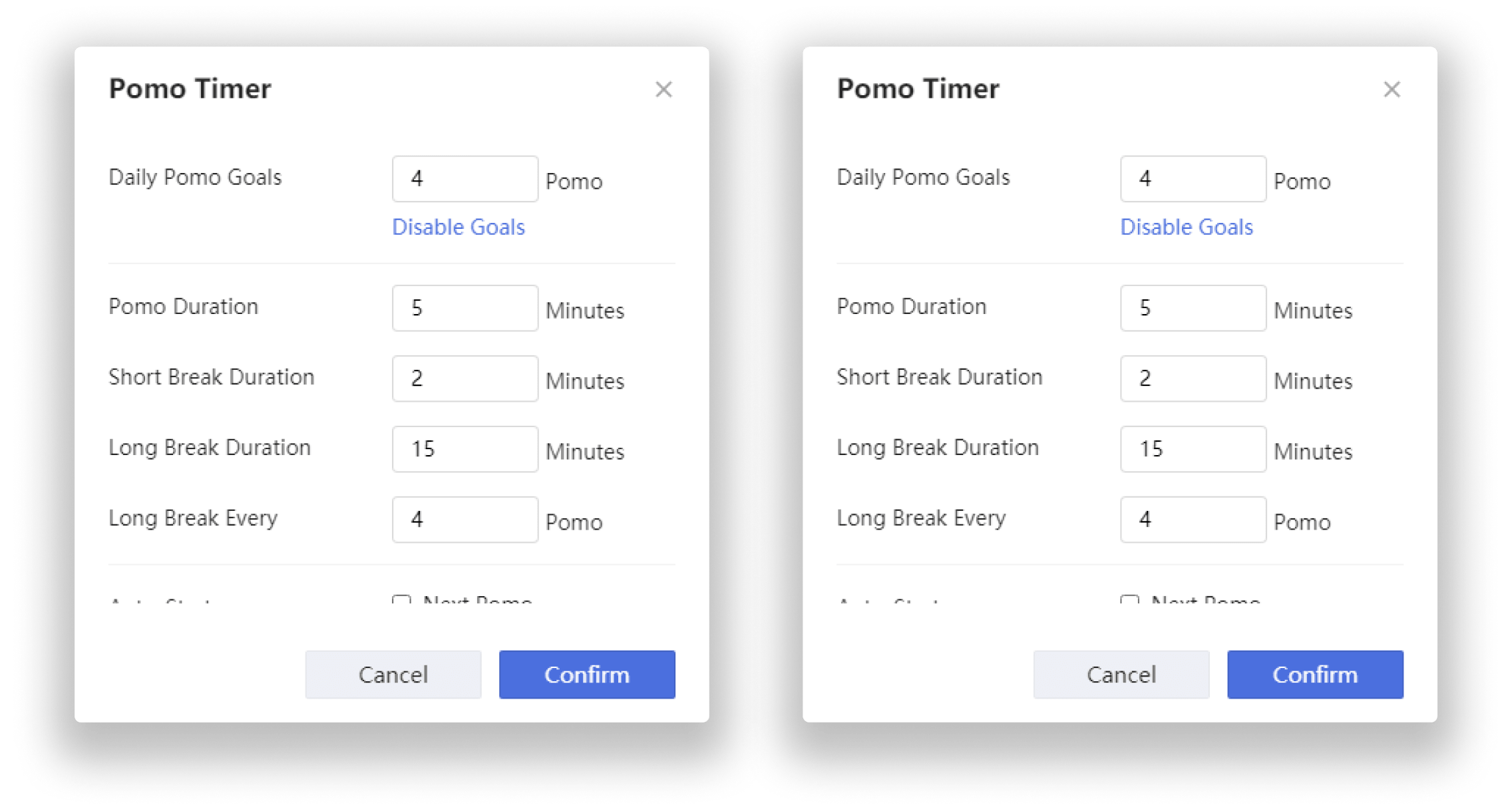
At the end of the period, you can hear a signal and see a pop-up with a notification that the tomato period is over, and it is time to take a break.
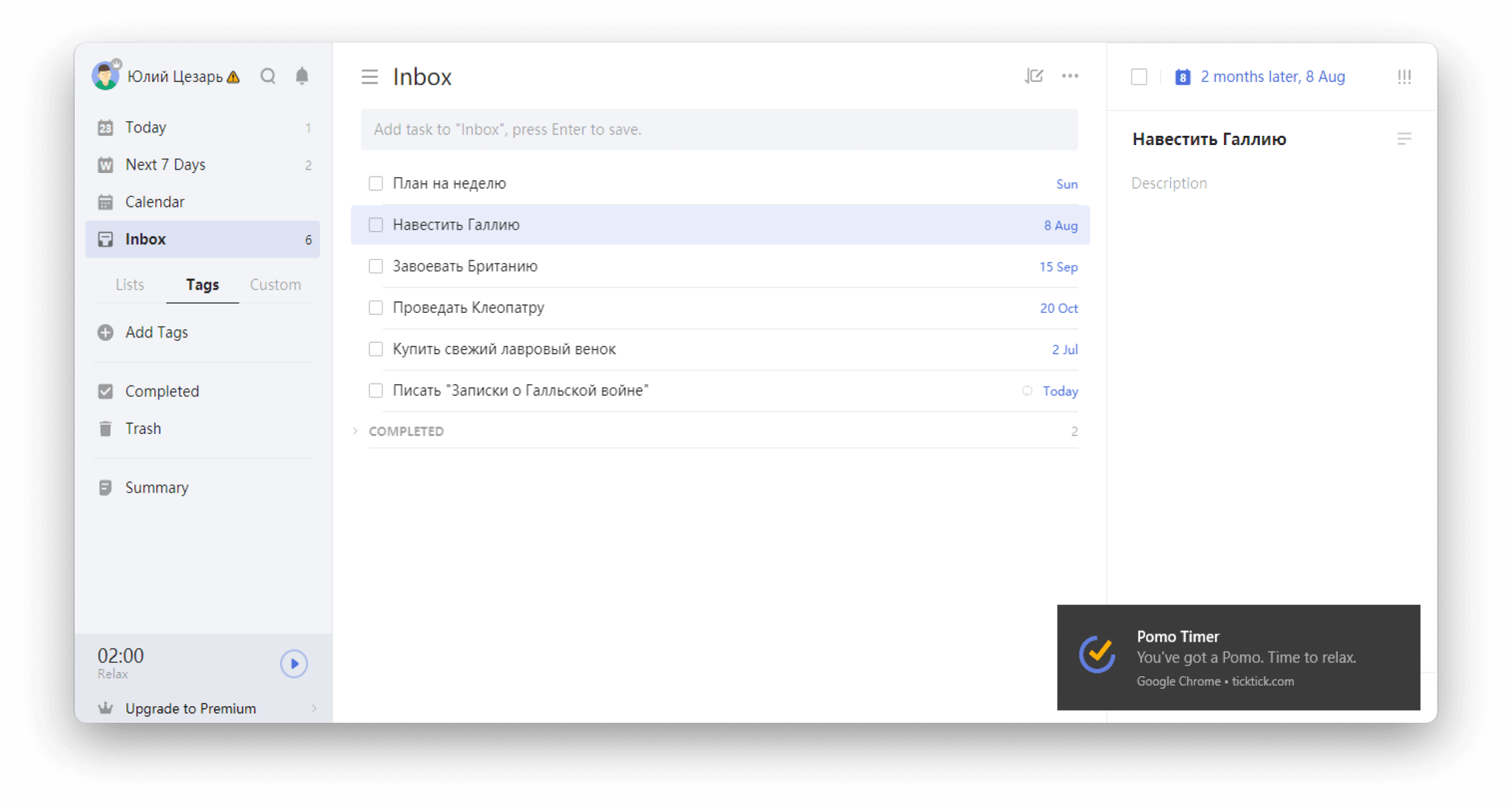
Weeek
Everything here is not like in all scheduling applications: the presentation of tasks for the day, and even the Pomodoro timer are different. You have to try very hard to customize the intervals to yourself. The interface is ABSOLUTELY not intuitive: you just click on everything like crazy.

To set up your intervals, you need to press the Set-Up button and then, in the interval boxes, enter the needed numbers by guess. Would you like a 5-minute 'tomato'? You have to try hard to position the cursor!
By the way, it is not at all clear why there are three boxes of numbers. Let’s imagine that, with great difficulty, you managed to customize the intervals, but at the end of the first interval, you will see something absolutely absurd:
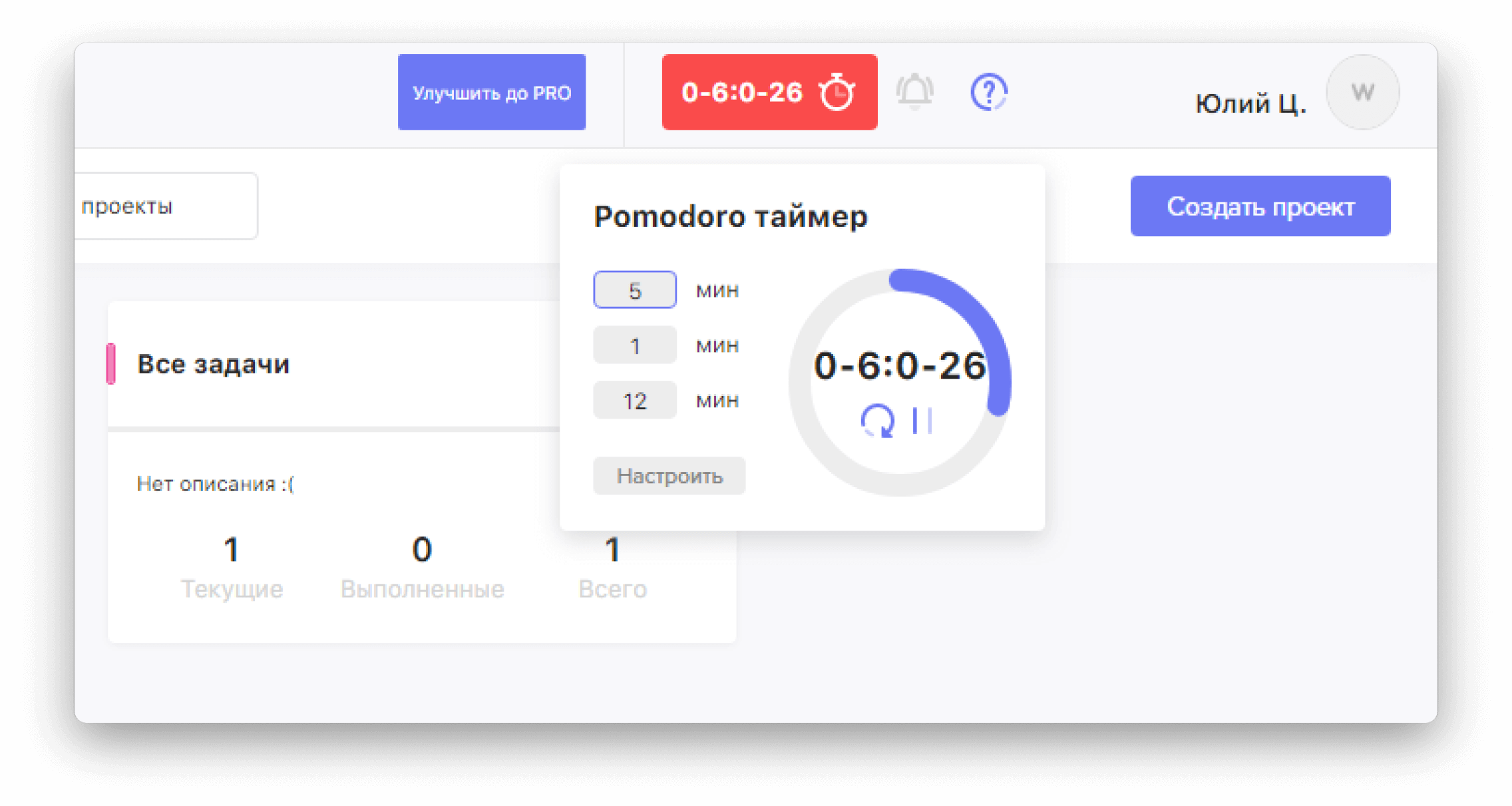
But there is something else: when the 'tomato' is finished, you can hear an awful alarm clock sound. The countdown rings for 7 seconds! It seems eternal and your hand is grabbing a sedative.
Tasklog
For those who want to learn a foreign language, there is Tasklog (used to be called Tomatoid). The classic task scheduler is combined with a CRM system. It has a simple timer to understand exactly how much time you spend on a task, and there is also the good old Pomodoro.
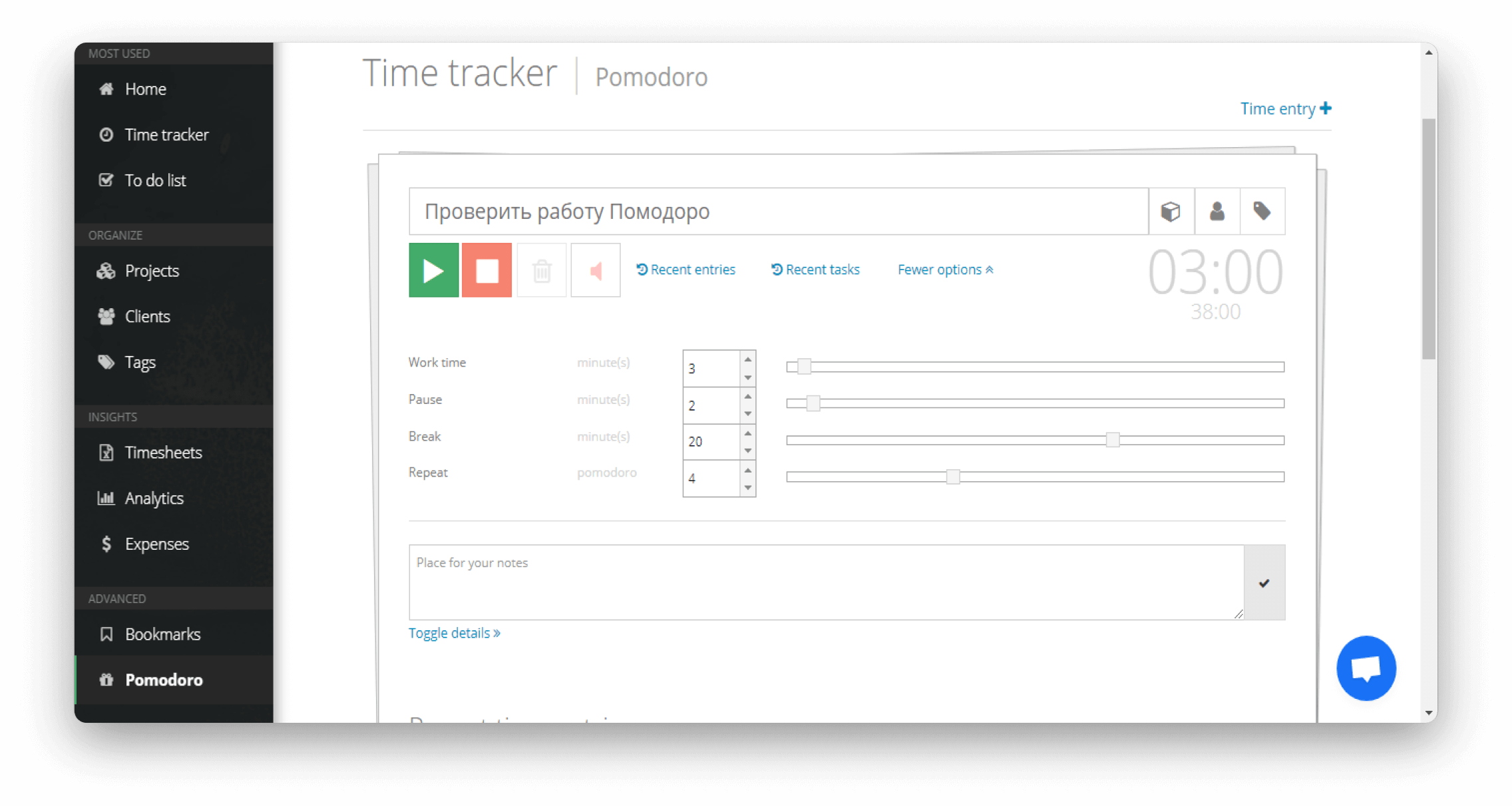
There is no notification sound at all. The progress indication at different intervals is … weird. But you can guess: the upper strip shows many 'tomatoes' have been passed in total, the lower one is the rest / work interval progress. Well, that’s it.
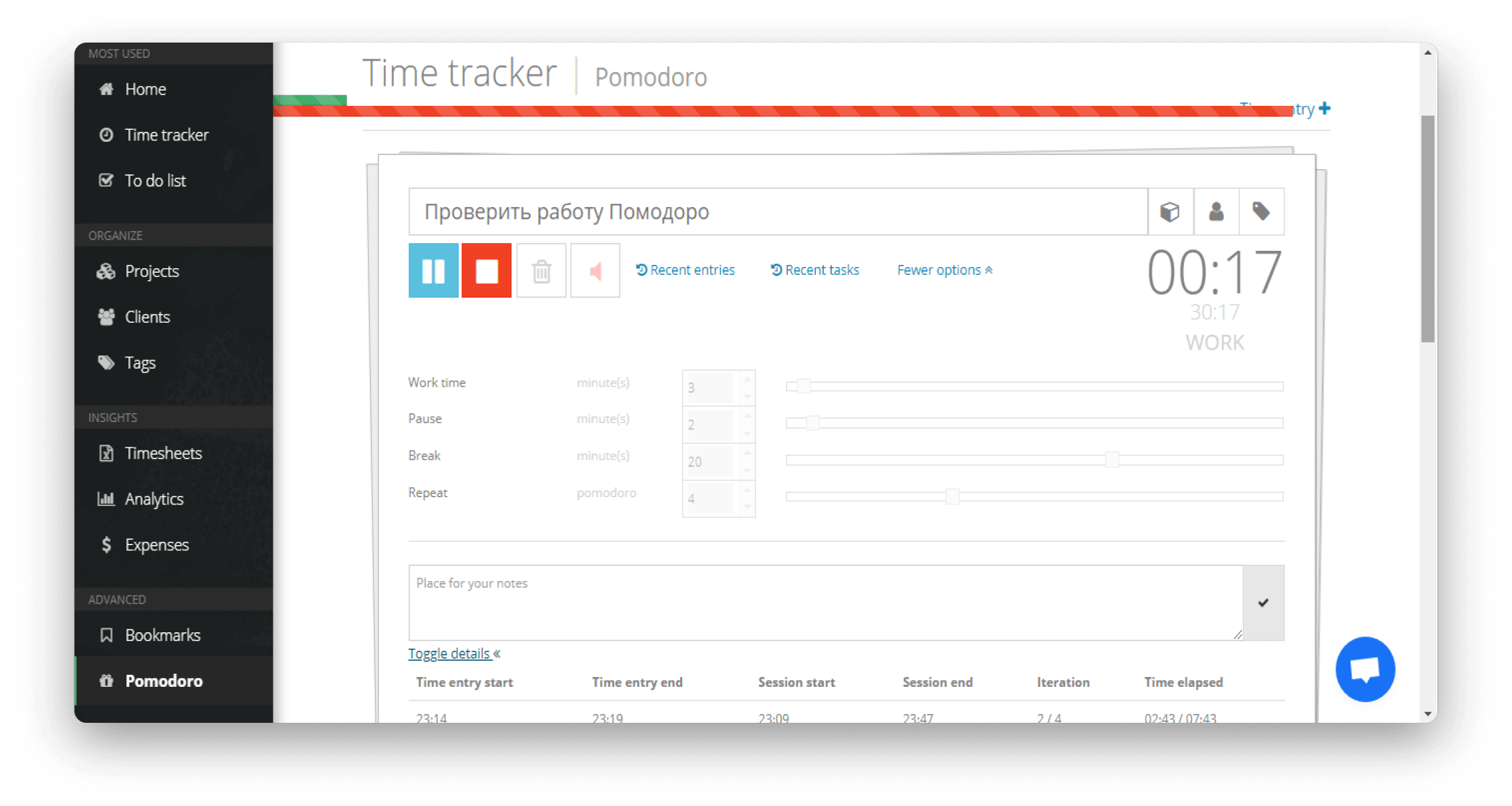
Lanes
This is a scheduler application with a simple set of options: you can view Today, Week, or add tasks to the Important folder. It is also rather hard to find Pomodoro’s timer there. It is in the settings for the created task. That means that the timer is bound to a specific task. When it’s done, start another one. There are not too many parameters in the timer settings: only the length of the intervals (you can set any).
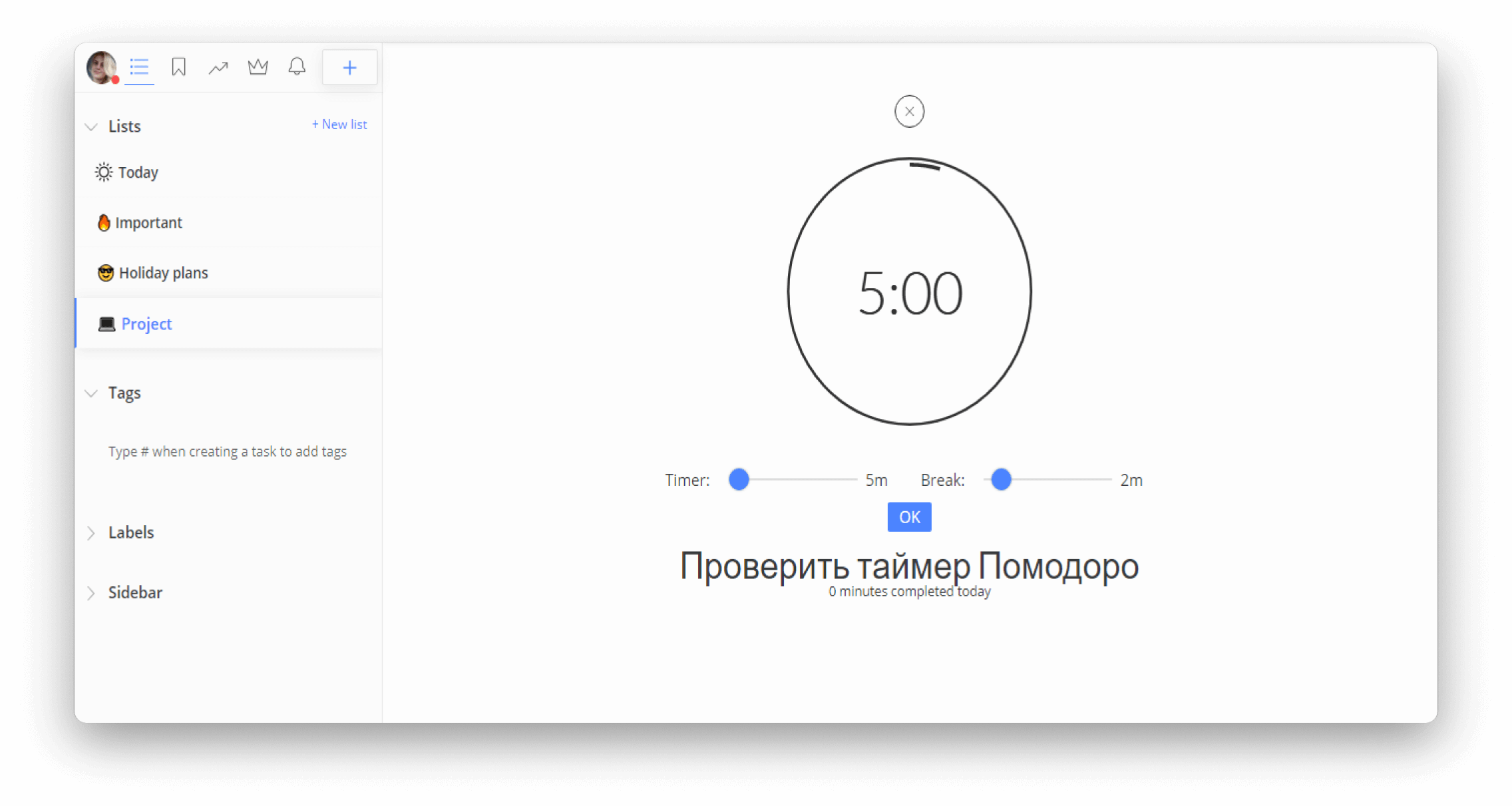
The interval progress is shown as a decreasing circle that is updated every minute. Almost like the second hand running in a watch. There is no sound indication. The rest interval looks very much the same as the interval progress:

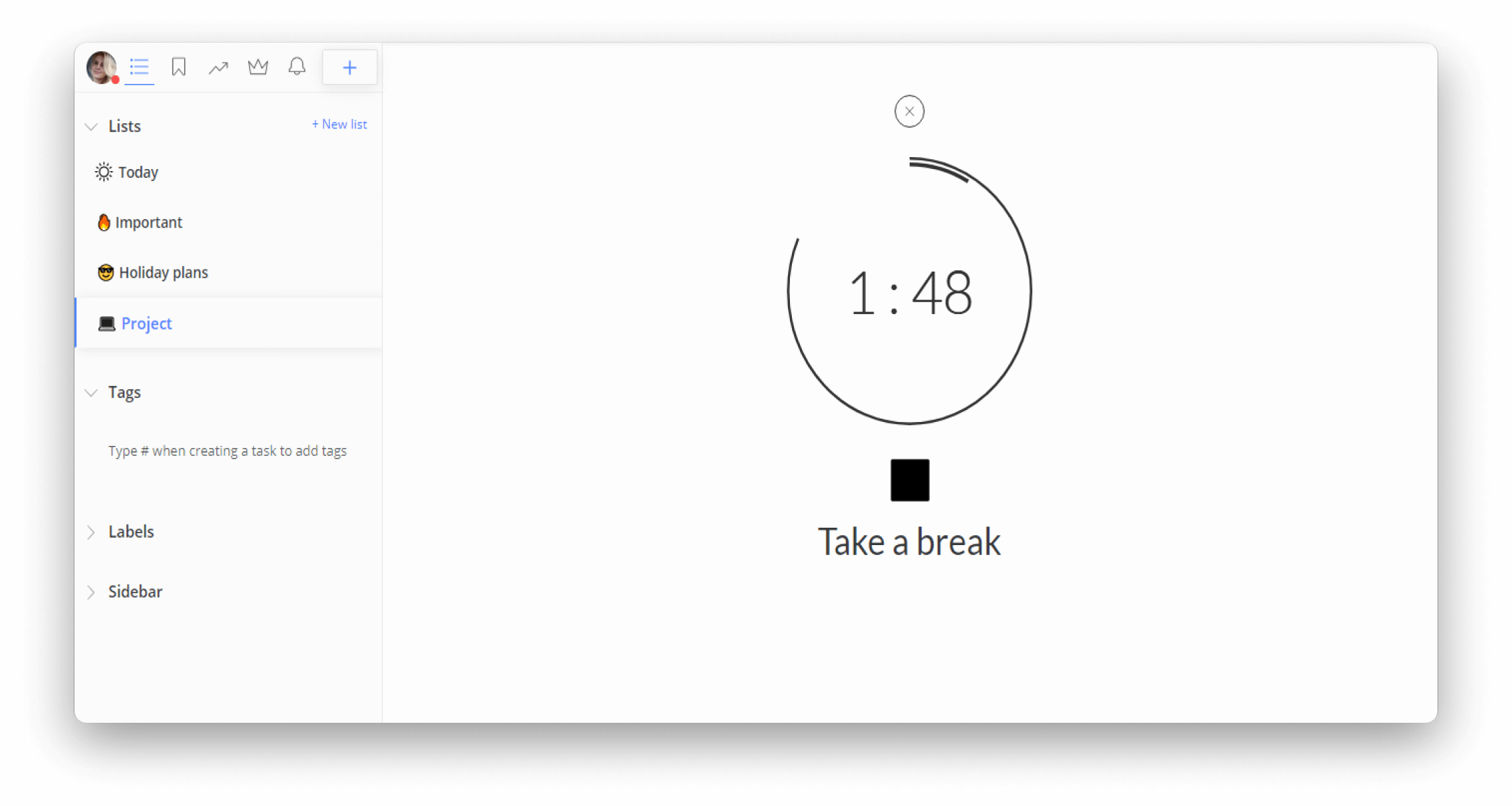
SingularityApp
Of course, the app for controlling chaos can’t fail to have Pomodoro (this feature, available in the free version, was checked out by the author of Jedi techniques, Maxim Dorofeev).
The timer is easy to find, there is an icon in the upper right corner. When you click on it, a window opens where you can select the 'tomato's' size. The completed 'tomato' cycles will be colored in the cells under the numbers.
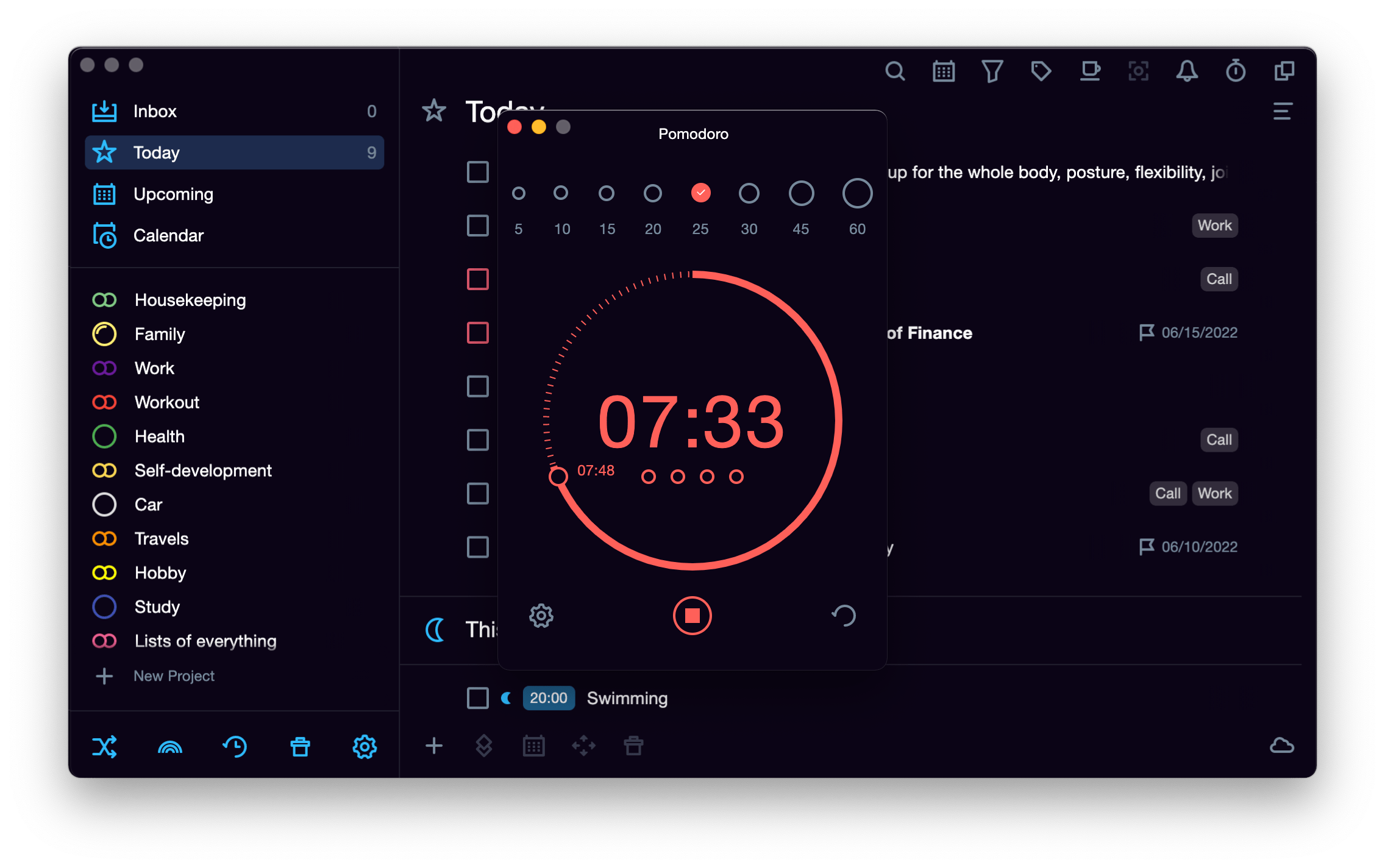
The time progress is displayed on the icon at the top — it gradually turns red. This is convenient if the timer window is minimized while you are working in the application or in another window.
The rest periods on the timer are colored green, the working periods are colored red. It’s hard to confuse :)
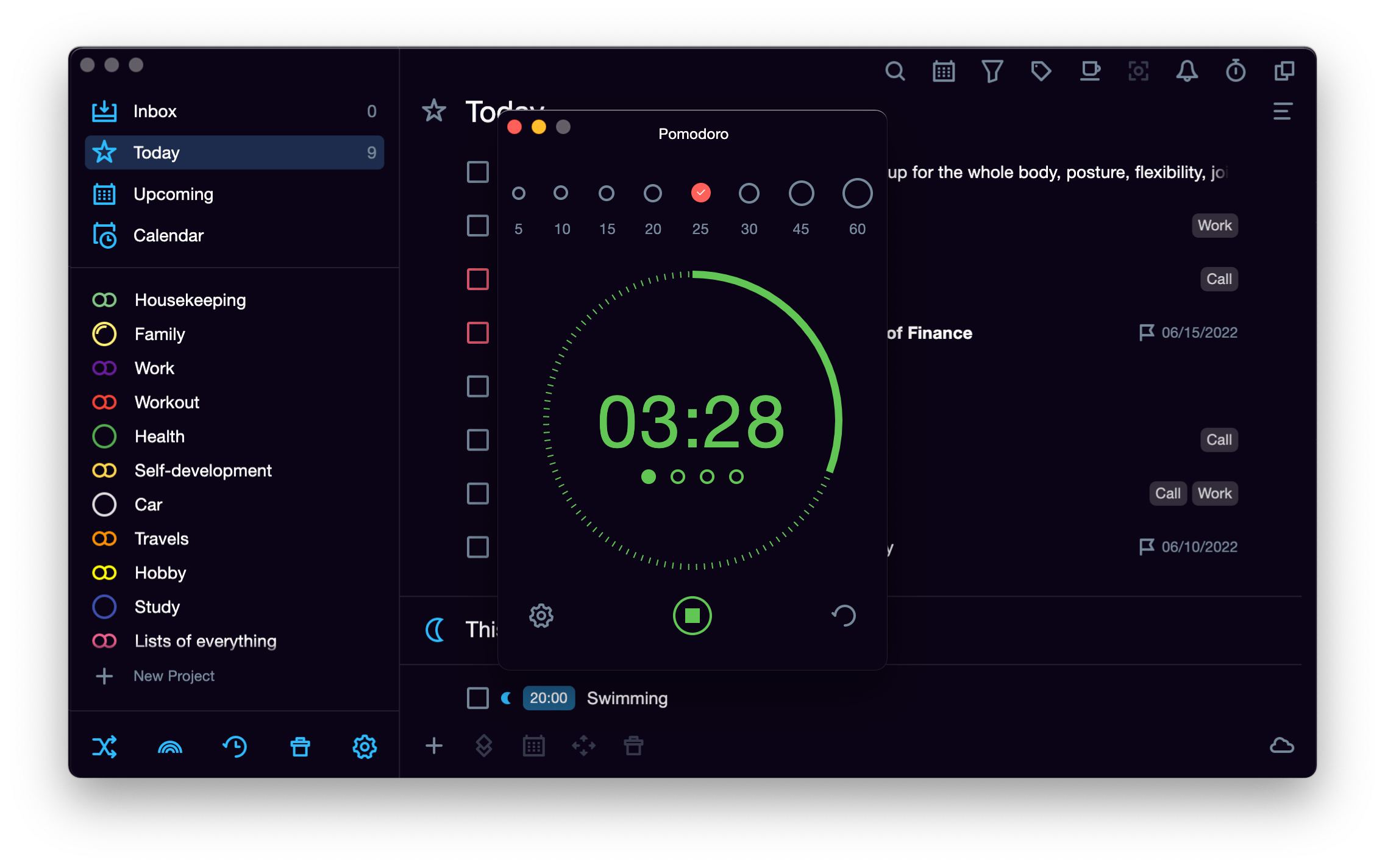
The timer can be customized — just click on the gear icon in the lower left corner of the timer window. There you can set the length and number of 'tomato' intervals and the duration of small and large rest breaks. Do you need a very long work interval? No problem!

By default, the sound of the timer is turned off, but if you really need a timer alert sound, you can add it. The sound will be pleasant and unobtrusive — like a message notification in a messenger. The new period starts automatically, but you can stop it. Very convenient.

We are sure that the timer in your favorite scheduler is very convenient. But if you don't like any of the above, try the services focused only on Pomodoro. Here are the most popular ones:
Pomodoro Tracker is another web service with less stylish design. But you can create tasks and check them when completed with the sound of ship arriving at the port (you also can hear the same sound when the 'tomato' cycle has come to an end). The settings are flexible: both the length and the number of intervals can be configured, the auto start of the tracker can be enabled / disabled, and you can even set goal for the day, i.e. how many 'tomatoes' you want to do.
And if you need super-motivation, try the Forest smartphone app which also has an element of game playing in order to do tasks and to get rid of phone addiction. To be focused on the task only, you plant tree in the application. If you use your phone before the interval is over, the tree dies. The more self-possession the thicker your forest will grow! But there is one problem: you have to pay for the application. The list of similar applications in stores is abundant. But that's another story :)
If you have not tried the Pomodoro technique yet, we highly recommend it. This is one of the easiest ways to improve your efficiency and reduce your time spent on tasks. And if you haven’t found your ideal planner yet — well, we’re not hinting at anything — here is a link to download SingularityApp, the most powerful planner for all your tasks, projects, lists, to-do's and appointments.





